Portraits of celebrities
Art, since ancient times, has always immortalized prominent personalities, who, initially, belonged mostly to the world of politics, such as Egyptian pharaohs, Roman and Byzantine emperors and, later, kings, popes and political figures of the Renaissance, seventeenth, nineteenth and twentieth centuries. Only since the fifties of this latter century, thanks to the innovative work of Andy Warhol, considered to be the greatest exponent of American Pop Art, are joined to the above categories also those of the characters of show business, which become the iconic spokesmen of the values a society now totally marked by the advent of consumerism.
 Thutmose, Bust of Nefertiti, circa 1345 BC. Limestone and stucco 50 x 30 cm. Berlin: Neues Museum.
Thutmose, Bust of Nefertiti, circa 1345 BC. Limestone and stucco 50 x 30 cm. Berlin: Neues Museum.
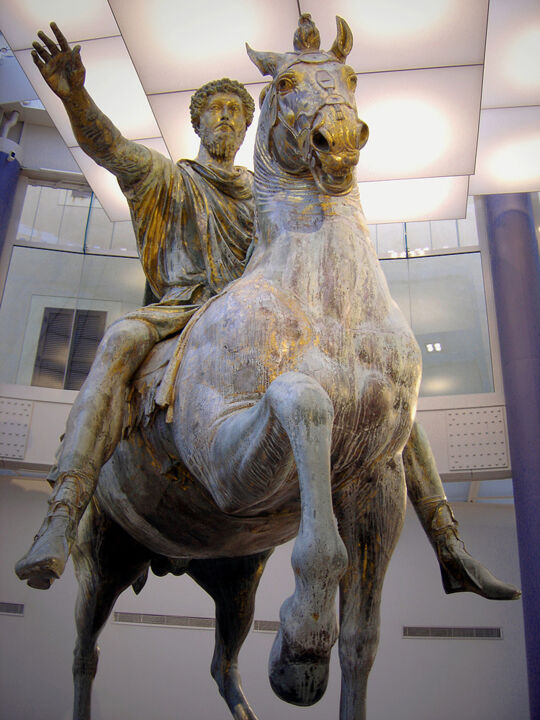 Equestrian statue of Marcus Aurelius, 176 or 180 AD. Gilded bronze, 400 x 230 x 410 cm. Rome: Piazza del Campidoglio.
Equestrian statue of Marcus Aurelius, 176 or 180 AD. Gilded bronze, 400 x 230 x 410 cm. Rome: Piazza del Campidoglio.
 Piero della Francesca, Double portrait of the Dukes of Urbino, 1467-1472. Oil on panel, 47 × 66 cm. Florence: Uffizi Gallery.
Piero della Francesca, Double portrait of the Dukes of Urbino, 1467-1472. Oil on panel, 47 × 66 cm. Florence: Uffizi Gallery.
 Raphael, Portrait of Julius II, 1511. Oil on panel, 108.7 × 80 cm. London: National Gallery.
Raphael, Portrait of Julius II, 1511. Oil on panel, 108.7 × 80 cm. London: National Gallery.
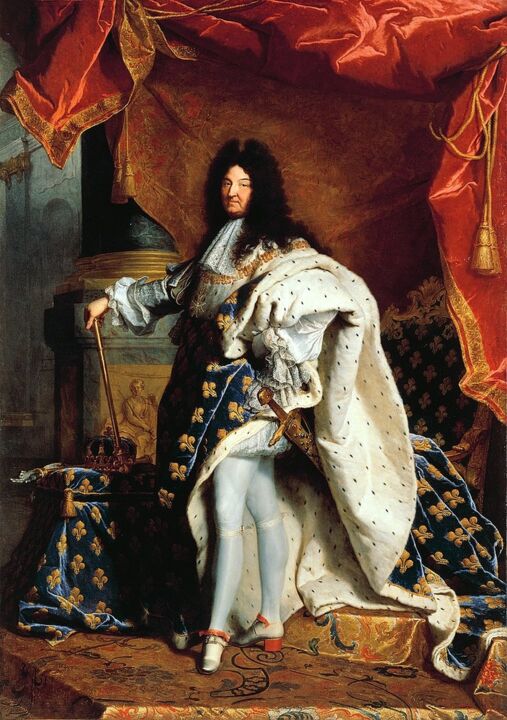 Hyacinthe Rigaud, Portrait of Louis XIV, 1701. Oil on canvas, 277 × 194 cm. Paris: Louvre Museum.
Hyacinthe Rigaud, Portrait of Louis XIV, 1701. Oil on canvas, 277 × 194 cm. Paris: Louvre Museum.
Andy Warhol, Green Marilyn, 1962. Acrylic and silkscreen ink on linen, 50.8 x 40.6 cm. Washington: National Gallery of Art. @todayisartday
Andy Warhol, Mao, 1973. Acrylic and silkscreen ink on linen, 127.3 × 107.6 cm . Washington: National Gallery of Art. @todayisartday
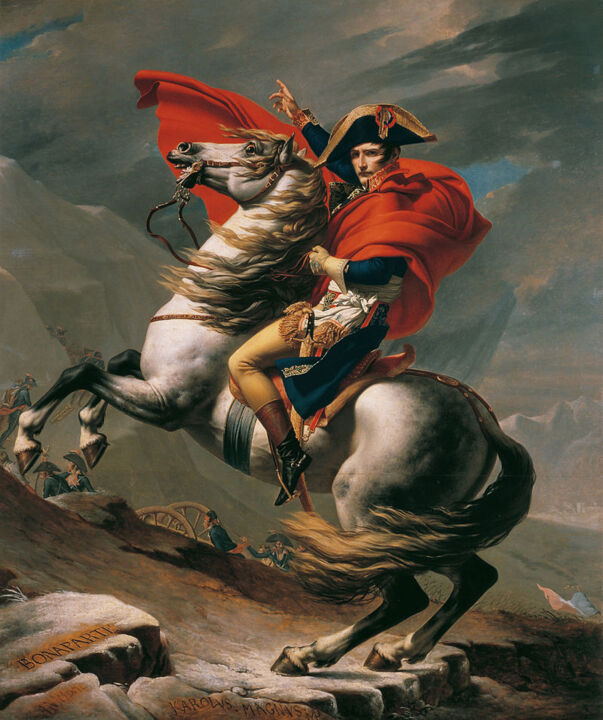 Jacques-Louis David, Bonaparte crossing the Great St. Bernard, 1800-1803. Oil on canvas, 260×221 cm. Versailles: Museum of the Palace of Versailles.
Jacques-Louis David, Bonaparte crossing the Great St. Bernard, 1800-1803. Oil on canvas, 260×221 cm. Versailles: Museum of the Palace of Versailles.
Jacques-Louis David: Bonaparte crossing the Great Saint Bernard
The famous painting by Jacques-Louis David, one of the most important painters of French Neoclassicism, immortalizes the First Consul, Napoleon Bonaparte, at the Great St. Bernard Passage, making clear reference to the way classical emperors were depicted. The innovative dynamism of the canvas, however, strongly detaches itself from the aforementioned tradition of equestrian portraits, bringing the masterpiece to be akin with the passion, tension and ferment of Romantic works. Moreover, this painting was meant to represent a true propaganda work, which the First Consul personally commissioned from the artist, in order to create a grandiose official imperial portrait. In fact, there are five versions of this same subject, which are preserved in different places: one at the Charlottenburg Castle, in Berlin, two at the Palace of Versailles, one at the collection of the Österreichische Galerie Belvedere and the fifth at the Musée National du Cháteau de Malmaison. Testifying to the aforementioned celebratory intent of the masterpiece is, in addition to the pose, the expression of confidence, determination and the ability to manage events with which Napoleon was immortalized. In addition, within the famous canvas, the name of the First Consul also appears "engraved" on a rock, together with that of other iconic figures of our history, such as Hannibal and Charlemagne, with the aim of conferring eternal glory on the great French leader. Finally, further celebrating the figure of Napoleon are the soldiers painted in the background of the work, who, unlike the majestic and deified First Consul, are much smaller, more fragile and vulnerable.
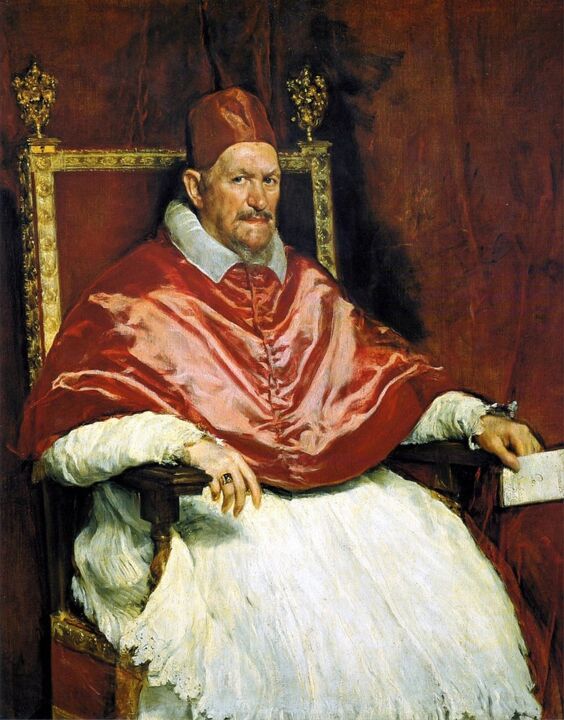 Diego Velásquez, Il ritratto di Papa Innocenzo X , 1650. Olio su tela, 140 × 120 cm. Roma Galleria Doria Pamphilj.
Diego Velásquez, Il ritratto di Papa Innocenzo X , 1650. Olio su tela, 140 × 120 cm. Roma Galleria Doria Pamphilj.
Diego Velásquez: The Portrait of Pope Innocent X
The masterpiece of Diego Velásquez, one of the most representative painters of the Baroque era, immortalized the features of Pope Innocent X, or Giovanni Battista Pamphili, a man marked by a difficult and reserved character, which was well expressed by the careful psychological rendering by the Spanish master. In the canvas, Innocent X, who is facing to the right, is shown seated in a precious pontifical armchair, resting his hands on the arms and staring decisively at the viewer. This intense expression is emphasized by the wrinkling of his eyebrows, his firmly closed lips and his posture, which exudes great ease, confidence and self-possession. As far as chromatism is concerned, the work is dominated by the color red, which is declined in every particular shade. The space of the portrait, however, is limited to framing the figure of the Pontiff and the back of his armchair, which are highlighted by the wise arrangement of light. It is good to highlight how the perspective with which the pontiff has been immortalized, the presence of the precious chair and the accurate pictorial technique of this important masterpiece strongly recall the Portrait of Julius II, dated 1511, made by the great Italian master Raphael. Finally, worthy of note is the strong interest that Francis Bacon had for the iconic Innocent X by Velásquez, so much so as to propose it in about forty-five very original interpretations, part of the so-called Screaming Pope series.
Andy Warhol immortalized with two versions of Liz Taylor's Portrait, the purple background and the green background. @popartrium
Andy Warhol: Portrait of Liz Taylor with green background
Andy Warhol's artistic production is characterized, in his most famous works, by the seriality with which objects and characters of the consumer society are depicted, which have become a symbol of the American lifestyle. These works, made in a mechanical way, through the technique of screen printing, were intended to allude to advertising campaigns and alienation of industrial society. The intent of this type of artistic production, however, was not to criticize, but simply to record, in a cold and detached way, the reality of an era. As for the silkscreen portrait of Liz Taylor, this one, made in different colors, is not a real portrait, but the reproduction of the public image of the diva. Regarding Liz Taylor on a green background, this artwork is characterized by colors with strong tones, which bring out the features of the actress, also giving it a certain dramatic intensity. In addition, the green takes on the task of bringing out the black, which distinguishes the hair and some physiognomic details of the diva, such as eyelids and eyes. Two other colors, which emerge strongly in the serigraphy, are the intense red of the lips and the water green of the eye shadow. Finally, the light of the work, strong and direct, creates intense shadows on the left profile of the subject depicted, in particular, in correspondence of the nose, mouth and eyes.
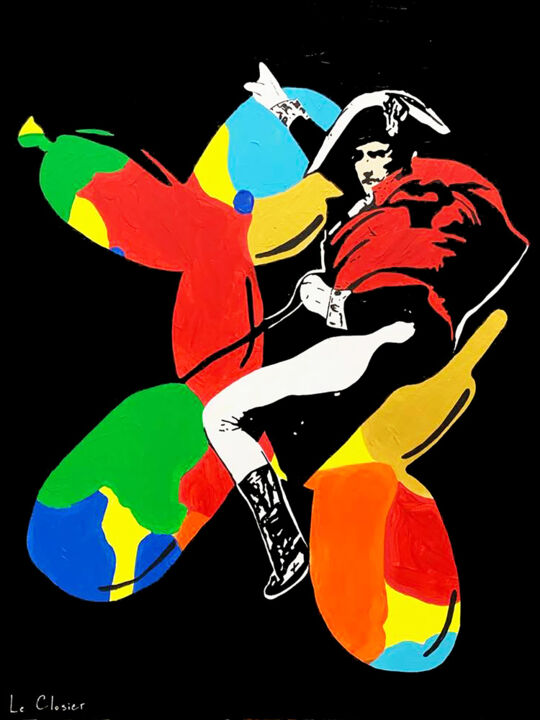 Le Closier, Napoleon on Baloon dog, 2020. Acrylic and spray paint on canvas, 101.6 x 76.2 cm.
Le Closier, Napoleon on Baloon dog, 2020. Acrylic and spray paint on canvas, 101.6 x 76.2 cm.
Le Closier: Napoleon on Baloon dog
Just like the greatest artists of all time, also those of Artmajeur have dedicated themselves to immortalize famous people, sometimes in a totally innovative way and, on other occasions, reinterpreting iconic paintings with originality. An example of what has been said is the very particular remake of Jacques-Louis David's painting, Bonaparte Crossing the Great St. Bernard, by Le Closier, in which, with many variations, the topic tackled by the French master has been reproposed. In fact, unlike the famous masterpiece, the protagonists of the painting by the artist from Artmajeur were depicted through the use of a painting technique similar to that of pop comics. Moreover, Napoleon on Baloon dog, deprived of the figurative background of the original, has lost its historical context, finding itself in a new, indefinite and eternal, space-time location. Moreover, Le Closier's horse has taken on the appearance of Jeff Koons' Baloon dog, even though, unlike the latter, it has not been made in the typical reflective monochrome. Finally, a further and inescapable distinctive element of the work of the artist from Artmajeur is irony, which replaces the seriousness of Jacques-Louis David's propaganda masterpiece.
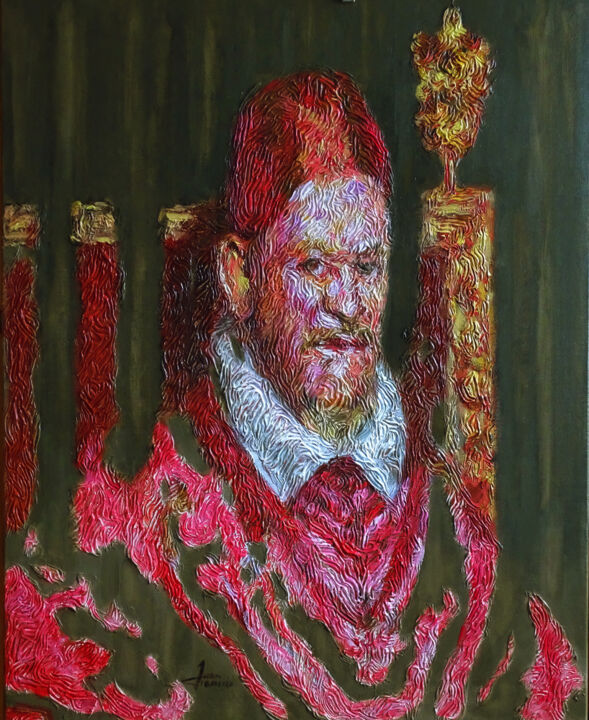 Juan Chamizo, Innocent X, 2021. Acrylic on canvas, 100x80 cm.
Juan Chamizo, Innocent X, 2021. Acrylic on canvas, 100x80 cm.
Juan Chamizo: Innocent X
The work of the artist of Artmajeur, Juan Chamizo, is a very personal tribute to the iconic Portrait of Pope Innocent X by Diego Velásquez, which is reproposed with an innovative, complex and accurate painting technique, through which the color is distributed on the support in a full-bodied and original way, but not uniform, so as to oppose smooth surfaces to layers of thicker paint. As far as the framing is concerned, Chamizo's canvas, unlike that of the Spanish master, presents the main subject in half-length, losing the precious details of the chair and the hands, with the intention of investigating with greater accuracy the psychology of the protagonist. In fact, the work of the artist of Artmajeur also stands out for its great ability to convey the feelings of the effigy, whose intense gaze almost seems to be real.
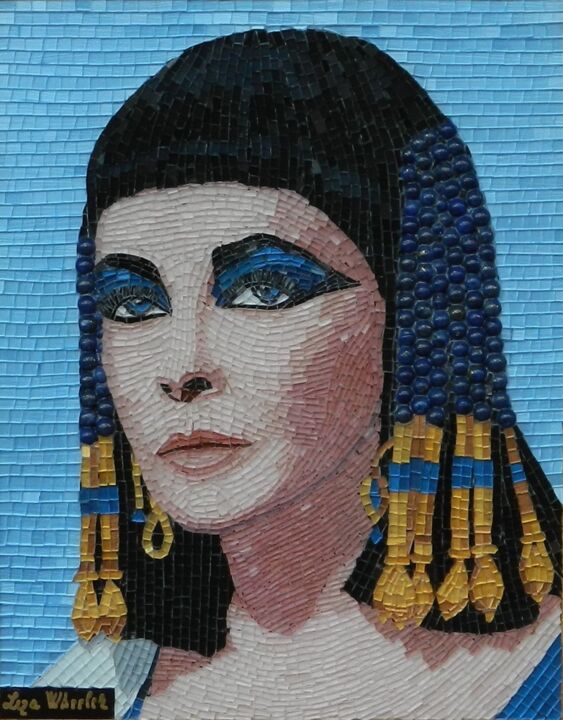 Liza Wheeler, Elizabeth Taylor as Cleopatra, 2013. Mosaic, 23.5 x 18.5 x 3 cm.
Liza Wheeler, Elizabeth Taylor as Cleopatra, 2013. Mosaic, 23.5 x 18.5 x 3 cm.
Liza Wheeler: Elizabeth Taylor as Cleopatra
The mosaic by Artmajeur's artist, Liza Wheeler, portrays, like Andy Warhol's silkscreen print from around 1963, the iconic, two-dimensional face of actress Liz Taylor, which, standing out against a background of uniform color, can be immediately deciphered by the viewer. Unlike the masterpiece of the American artist, however, the originality, difficulty and extreme manual skill that distinguish the technique of the mosaic, generate an innovative and personal work, probably aimed at moving away from the serial production with which many pop masterpieces have been made, in order to promote a return to the creation of unique and unrepeatable works of art, capable of showing the inspiration and genius of those who created them. Finally, other differences that the mosaic of the artist of Artmajeur presents compared to the above-mentioned silkscreen, concern the mode of execution of the subject depicted, since Liz Taylor, immortalized innovatively in the clothes of Cleopatra, is characterized by refined colors and realistic shades, which are totally opposed to the vast fields of monochrome color of the works of Andy Warhol.

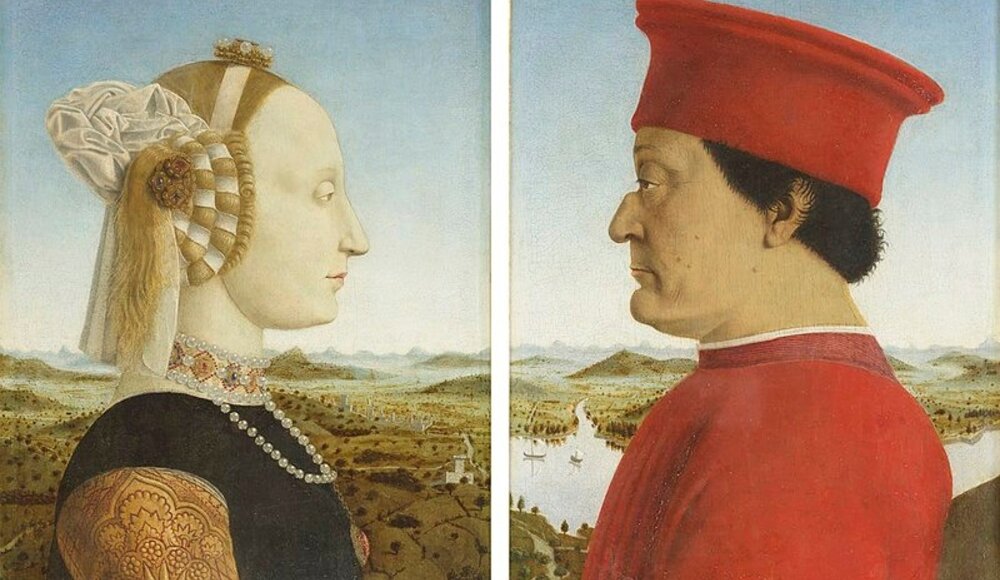
 Olimpia Gaia Martinelli
Olimpia Gaia Martinelli























